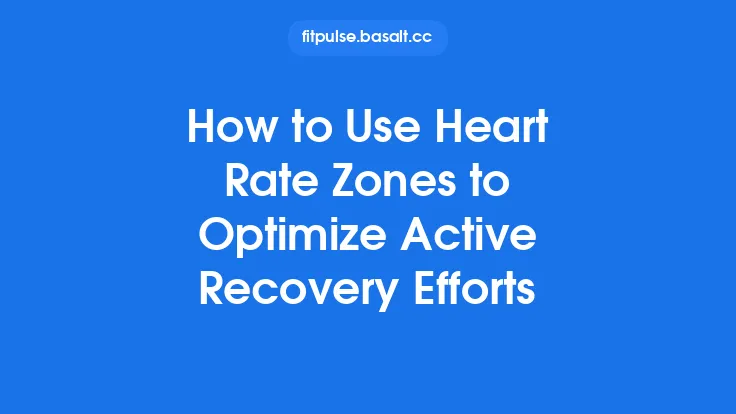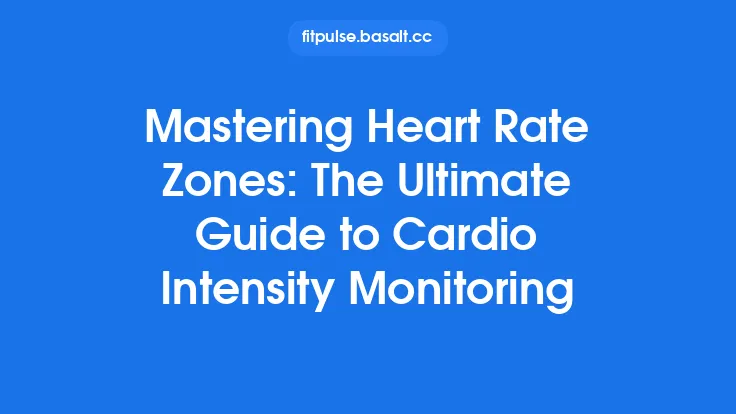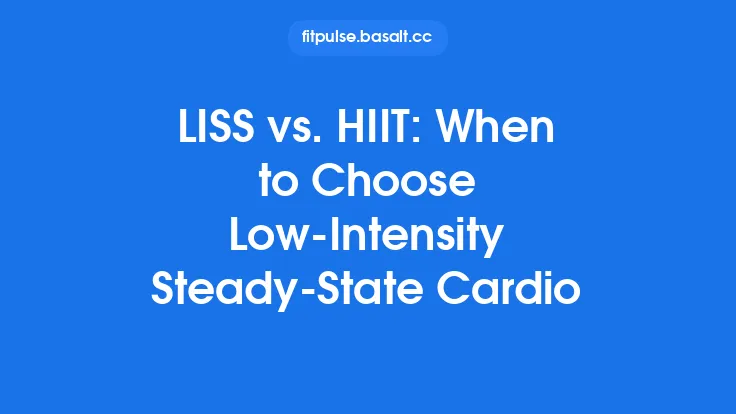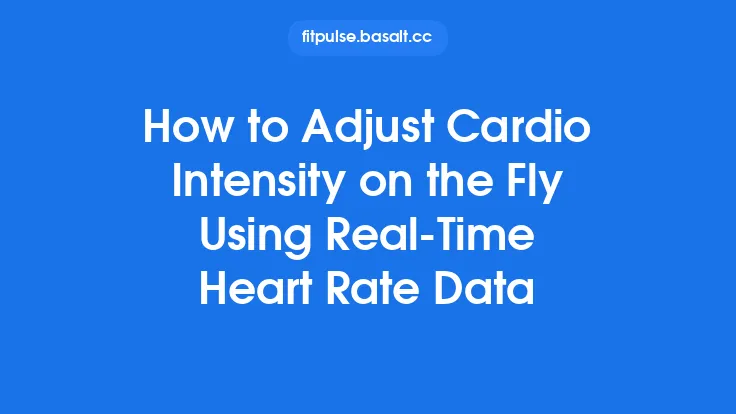When it comes to cardio conditioning, two of the most widely referenced tools for gauging effort are heart‑rate zones and the Rating of Perceived Exertion (RPE). Both aim to answer the same fundamental question—how hard am I working?—but they do so from opposite ends of the physiological spectrum. One leans on an objective, measurable signal from your cardiovascular system; the other trusts the brain’s internal gauge of strain. Understanding the nuances of each method, and knowing when to lean on one versus the other, can make the difference between a workout that simply “gets you moving” and one that truly advances your fitness goals.
Understanding the Core Concepts
Heart‑Rate Zones
Heart‑rate zones are ranges of beats per minute (bpm) that correspond to different percentages of an individual’s maximal heart rate (HRmax). By staying within a given zone, you can target specific energy systems (e.g., aerobic vs. anaerobic) and physiological adaptations (e.g., mitochondrial density, capillary growth).
Rating of Perceived Exertion (RPE)
RPE is a subjective scale—most commonly a 0‑10 or 6‑20 numeric system—where you assign a number that reflects how hard the activity feels at that moment. The rating incorporates not only cardiovascular strain but also muscular fatigue, breathing effort, temperature, hydration status, and even mental stress.
Both metrics are rooted in the principle of intensity regulation: they help you stay within a desired training window, avoid over‑ or under‑training, and track progress over time.
How Heart‑Rate Zones Are Determined
The most common approach is to express zones as percentages of HRmax (e.g., 60‑70 % HRmax for a “moderate” zone). HRmax itself can be estimated using age‑based formulas (e.g., 220 – age) or, more accurately, derived from a maximal effort test or a recent race effort. Once HRmax is known, zones are carved out:
| Zone | % of HRmax | Typical Physiological Emphasis |
|---|---|---|
| Zone 1 | 50‑60 % | Recovery, basic circulation |
| Zone 2 | 60‑70 % | Aerobic base, fat oxidation |
| Zone 3 | 70‑80 % | Tempo work, lactate threshold |
| Zone 4 | 80‑90 % | High‑intensity intervals, VO₂ max |
| Zone 5 | 90‑100 % | Sprint/anaerobic capacity |
Because heart‑rate is a direct readout of cardiac output, it provides a physiologically anchored window that is relatively stable across days—provided external factors (temperature, caffeine, dehydration) are controlled.
The Mechanics of Perceived Exertion
RPE is essentially the brain’s integration of multiple afferent signals:
- Cardiovascular feedback – heart‑rate, stroke volume, blood pressure.
- Respiratory cues – breathing frequency, depth, and the sensation of breathlessness.
- Muscular input – local fatigue, joint stress, and the accumulation of metabolic by‑products.
- Environmental context – heat, humidity, altitude, terrain.
- Psychological state – motivation, stress, sleep quality.
When you assign an RPE number, you are synthesizing all of these inputs into a single, actionable rating. Because it is subjective, RPE can adapt instantly to changes that a heart‑rate monitor might miss (e.g., a sudden hill, a bout of anxiety, or a cold day that suppresses heart‑rate response).
Strengths of Heart‑Rate Zone Monitoring
| Advantage | Why It Matters |
|---|---|
| Objective data | Numbers are reproducible and easy to compare across sessions. |
| Clear physiological link | Directly reflects cardiac workload, which is central to cardiovascular adaptations. |
| Fine‑grained pacing | Enables precise interval timing (e.g., “hold 150 bpm for 2 min”). |
| Compatibility with training software | Most platforms accept HR data for automated zone calculations and progress tracking. |
| Useful for medical or rehab contexts | Clinicians often require a quantifiable metric to ensure safety. |
Strengths of RPE‑Based Monitoring
| Advantage | Why It Matters |
|---|---|
| Holistic view of effort | Captures factors beyond heart‑rate, such as muscle fatigue and environmental stress. |
| No equipment required | Perfect for sessions where a monitor is impractical (e.g., swimming, trail running). |
| Rapid adaptability | You can instantly adjust intensity if you feel unusually fatigued or energized. |
| Cost‑effective | No need for a heart‑rate strap, smartwatch, or battery management. |
| Promotes body awareness | Encourages athletes to listen to internal cues, fostering long‑term self‑regulation skills. |
Situations Favoring Heart‑Rate Zones
- Structured interval training – When the goal is to hit specific cardiovascular thresholds (e.g., VO₂ max intervals), a heart‑rate target provides a concrete anchor.
- Long‑duration endurance sessions – For marathon or ultra‑distance preparation, staying within a prescribed zone helps manage glycogen depletion and fatigue.
- Clinical or rehabilitative programs – Physicians and physical therapists often prescribe HR limits to keep patients within safe boundaries.
- Data‑driven performance analysis – Athletes who track trends over months (e.g., HR drift, recovery heart‑rate) benefit from the consistency of HR data.
- Cold or hot environments where perception can be misleading – In extreme temperatures, the body’s perception of effort may be distorted, while heart‑rate still reflects true cardiovascular strain.
Situations Favoring RPE
- Variable terrain or outdoor play – Hill repeats, trail runs, or sports with frequent direction changes make heart‑rate lag a limitation; RPE captures the immediate load.
- Limited technology access – When training without a monitor (e.g., group classes, travel, swimming), RPE remains a reliable guide.
- Early‑stage conditioning – Beginners often benefit from learning to “feel” their effort before adding the complexity of HR data.
- High‑stress or low‑sleep days – Psychological factors can elevate perceived effort even if heart‑rate remains modest; RPE helps prevent over‑training.
- Recovery or “active rest” days – A low RPE (e.g., 2‑3/10) can be a simpler way to ensure the session stays easy, without obsessing over heart‑rate numbers that may fluctuate due to lingering fatigue.
Practical Tips for Choosing the Right Metric
| Decision Factor | Heart‑Rate Zones | RPE |
|---|---|---|
| Goal specificity | Precise physiological targets (e.g., improve lactate threshold) | General effort control (e.g., “run easy”) |
| Equipment availability | Requires a reliable monitor | No equipment needed |
| Training environment | Stable, indoor or predictable outdoor conditions | Variable terrain, extreme weather |
| Experience level | Intermediate to advanced athletes comfortable with data | Beginners or those new to structured cardio |
| Health considerations | Need for strict safety limits (e.g., cardiac rehab) | Situations where HR may be unreliable (e.g., medication affecting HR) |
A simple decision tree can help:
- Do you have a trustworthy heart‑rate monitor?
- Yes: Consider HR zones for sessions where precise cardiovascular load matters.
- No: Default to RPE.
- Is the workout environment highly variable (hills, heat, cold, water)?
- Yes: Lean toward RPE.
- No: HR zones remain viable.
- Are you training for a specific physiological adaptation (e.g., VO₂ max, lactate threshold)?
- Yes: HR zones give a clearer target.
- No: RPE may be sufficient.
Common Pitfalls to Watch For
- Relying on a single metric exclusively – Over‑reliance on HR can blind you to muscular fatigue; over‑reliance on RPE can miss subtle cardiovascular drift.
- Ignoring external influences on heart‑rate – Caffeine, dehydration, stress, and certain medications can shift HR independent of effort.
- Using an outdated HRmax – As fitness improves or age advances, HRmax can change; periodic reassessment keeps zones accurate.
- Misinterpreting “low” RPE on a hot day – Heat can suppress perceived effort while heart‑rate climbs sharply; in such cases, a quick HR check can prevent overheating.
- Failing to calibrate RPE – New athletes often rate effort too low or too high; a brief calibration session (e.g., a 5‑minute walk, jog, and sprint) helps anchor the scale.
Summary and Takeaways
Both heart‑rate zones and the Rating of Perceived Exertion are valuable lenses through which to view cardio intensity. Heart‑rate zones excel when you need an objective, physiologically grounded target—especially for interval work, long‑duration endurance, or medically supervised training. RPE, on the other hand, shines in environments where the body’s internal feedback is more reliable than a numeric pulse, such as on uneven terrain, during recovery, or when technology is unavailable.
The most effective cardio program often knows when to use each tool rather than insisting on a one‑size‑fits‑all approach. By understanding the strengths, limitations, and ideal contexts for each metric, you can tailor your training to match your goals, environment, and personal preferences—ultimately leading to smarter, safer, and more enjoyable cardio sessions.





